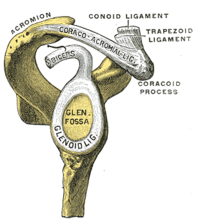
Photo from wikipedia
Background Type II superior labrum anterior and posterior (SLAP) lesions could induce chronic shoulder pain and impaired movement. Current management of Type II SLAP lesions consists of two well-established surgical… Click to show full abstract
Background Type II superior labrum anterior and posterior (SLAP) lesions could induce chronic shoulder pain and impaired movement. Current management of Type II SLAP lesions consists of two well-established surgical procedures: arthroscopic biceps tenodesis and SLAP repair. However, which technique is preferred over the other is still a controversy. Methods We performed a systematic electronic database search on Cochrane Central Register of Controlled Trials, MEDLINE and Embase to identify articles equating superior labral repair with biceps tenodesis, which were reported before August 2017 which included the phrase “superior labral anterior posterior” or “SLAP.” The randomised controlled clinical trials that met our criteria were evaluated for quality of methodology. The results obtained were further analysed and correlated to present the benefits and drawbacks comparing the two SLAP repair surgical procedures. Result Based on our inclusion and exclusion criteria, we identified five articles (204 patients) that were included in this meta-analysis. The results indicate that prevalence of patients return to preinjury sports level and the patients satisfaction were found to be significantly better in tenodesis group than in the SLAP repair group (p < 0.05). As for the patient age, VAS score, American Shoulder and Elbow Surgeons score, University of California at Los Angeles score, postoperative stiffness and reoperation rates, no significant differences were evident among the two groups, thus supporting the results reported in the current literatures (p > 0.05). Conclusions Both the surgical treatments, SLAP repair and the biceps tenodesis, are efficacious in pain alleviation and recovery of shoulder function. But, compared with SLAP repair, biceps tenodesis showed higher rate of patient satisfaction and return to preinjury sports participation. The translational potential of this article Impart better understanding regarding discrepancies in the outcomes between biceps tenodesis and SLAP repair in treating patients with isolated Type II SLAP lesions.
Journal Title: Journal of Orthopaedic Translation
Year Published: 2019
Link to full text (if available)
Share on Social Media: Sign Up to like & get
recommendations!